#verulamium
Text
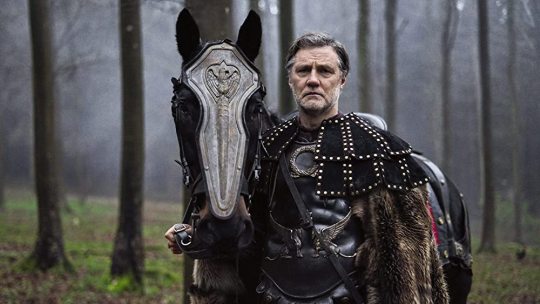
David Morrissey as Aulus in "Britannia"(2017-)
S3E1
Aulus has built himself a smart villa overlooking the new town of Verulamium. But underneath, Druids and Celtic tribes still resist power.
*Verulamium was sited southwest of the modern city of St.Albans in Hertfordshire,England
#Britannia#tv series#S3E1#Aulus#Roman era#Roman invasion#druids#Verulamium#Celtic tribes#action#drama#fantasy#period drama#season premiere
0 notes
Text

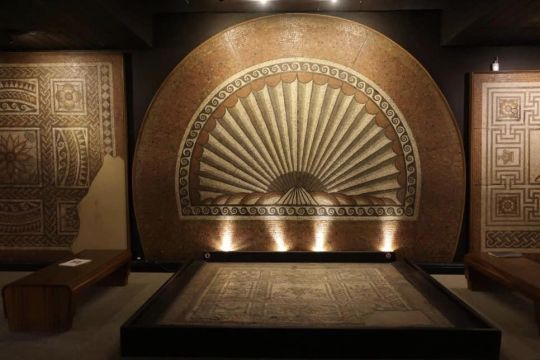
Roman mosaic, the shell, at the Verulamium Museum. St. Albans, Hertfordshire, England.
Verulamium was a Roman settlement conquered by the Romans during their invasion of Britain in 43 AD. Burned to the ground during the Boudica Revolt in 61 AD, the Romans rebuilt it. Verulamium became one of the largest and most prosperous cities in the province of Britannia.
By: G. Brabec
105 notes
·
View notes
Text

"Queen of the Iceni tribe during the Roman occupation of Britain. In either 60 or 61 AD Boudica united different tribes in a Celtic revolt against Roman rule. Leading an army of around 100,000 she succeeded in driving the Romans out of modern-day Colchester (then capital of Roman Britain), London and Verulamium (St Albans).
Her success led Roman emperor Nero to consider withdrawing from Britain entirely, until the Roman governor, Paullinus finally defeated her in a battle in the West Midlands. Shortly afterwards Boudicca died, probably either by suicide or through illness."
73 notes
·
View notes
Text
Wonka Locations
from this article, and this article.
The Library, where Dorothy Smith (Noodle's mum) lives - Radcliffe Camera, Oxford (a real university library) (Oxford is in the south of England, basically middle of the land in between the bits of land that look like they've had their belt tightened too much).

The bridge that Abigail the Giraffe has to duck under - Hertford Bridge/the Bridge of Sighs, Oxford (again).
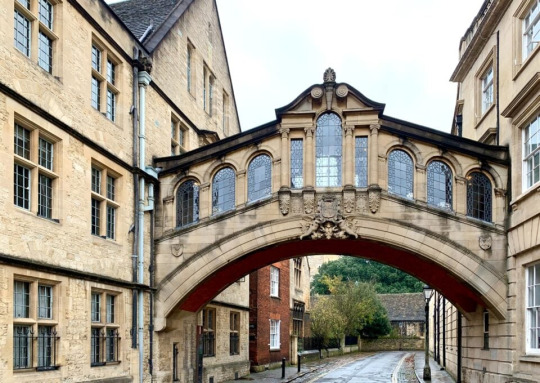
The river where the Wonka's lived - Mapledurham, Berkshire (to the left of London, in the middle of the land, on the Thames).

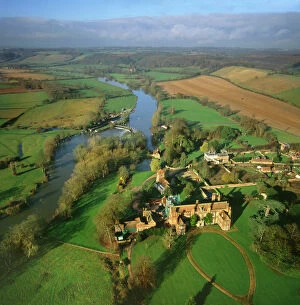
The city's port/lighthouse - Lyme Regis, Dorset (the Cobb specifically i think - southern coast of England, halfway down the wiggly tail looking bit)


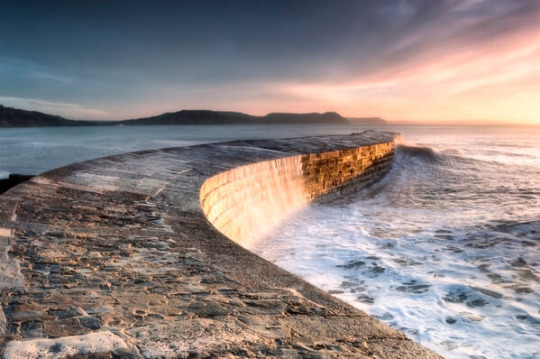
Where Willy gives the homeless woman his money, loses his last coin and meets Bleacher and Tiddles - The Colonnade/Parade Gardens, Bath (a bit inland from the start of the wiggly tail bit)


St Benedict's Cathedral (inside only?) (the entrance to the Chocolate Cartel's underground base, where they try to drown Willy and Noodle) - St Paul's Cathedral, London.
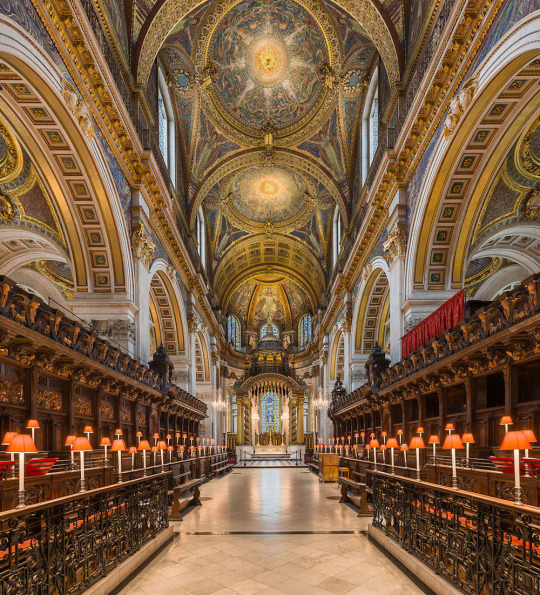
Where Larry Chucklesworth does his stand-up and wins back his wife - Rivoli Ballroom, Brockley (London) (inside only)
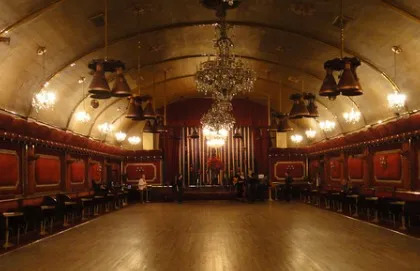
Slugworth's Office - Eltham Palace, Greenwich (London).

The Zoo where Abigail the Giraffe is (only the lake was used, the rest was built on a set) - Verulamium Park, St Albans (just north of London, if not in London).

Where Slugworth's car is blocked by Flamingos - Bath Street, Bath (again).
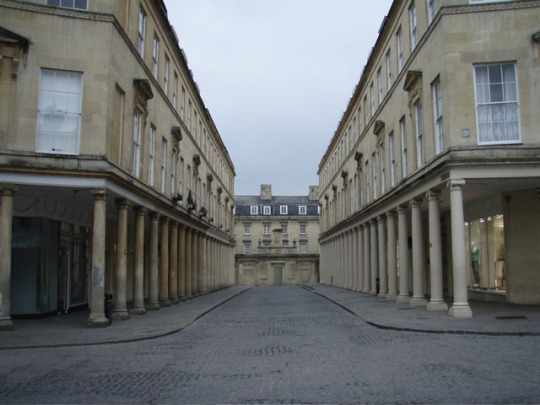
Where Willy builds his factory with Lofty - Bodiam Castle, South England (south of London)
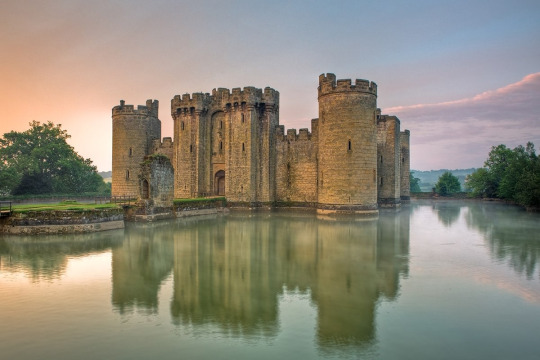
29 notes
·
View notes
Text
i remember when i was first studying roman britain our teacher would ask us to point to, idk, Verulamium on a map. and nobody could do it. "come on guys!! it's st albans!" nobody could point to that either so it didn't help
SO she got some maps of britain and taught us where stuff was and tested us on our ability to draw roman towns onto a blank map and gradually we improved at it
but specifically we learned to put the roman towns on the map. so sometimes i'll still be blanking until someone gives me the roman name and then i'm like. oh yeah i know where venta silurum is. why didn't you just say that
#although it's been ten years so I'm not sure i can still reliably draw them on#anyway this is the only kind of geography i ever learned. historic geography#and only bc our teacher realised we had never been any of these places and didn't know where they were lol
28 notes
·
View notes
Text

And here’s the reveal! The album art for my new album, “Ganymede Gives Up The Ghost”! The album will be available on December 1st wherever you get music
So let’s talk about it! This album has been an uncharacteristically personal experience for me, which a much more explicit look at my life than I’m normally writing about. I was listening to “Transgender Dysphoria Blues” by Against Me about a year ago and got to thinking about how it was closer than anything I’d heard to my experience as a trans person, but still not quite the same, and then, in a truly cartoonish realization, I remembered that I am, in fact, a musician with all the power to change that lol
It’s got Stuffy Doll’s first feature, Riley Silverman, because if there’s one thing I’ve learned in my trans journey, it’s that we can accomplish so much more when we work together. It’s got a bonus track, which is a reimagining of my song “Protomartyr In Verulamium” that sounds profoundly different from the original because the story of that song is about finding and providing refuge to the lost. “Give me refugees, mouths to feed”. When I first wrote those lines, I was preparing to move across the country to a new place, hoping I’d find something good when I got there. Now they remind me of our duty to each other, and I thought it made for the perfect end to an album about marginalization.
The stuff up in the top left corner is:
14 because this is my 14th album
December because that’s when it comes out
120492 cuz that’s my birthday
This incredible album art is, of course, by @ghostcashew , who I can never thank enough for his dogmatic support.
So ask me any questions you’d like! I’m here to answer them. I love you all, thank you for being a part of this.
#music recs#lgbtq musicians#indie music#new music#indie singer songwriter#unsignedbands#lgbtq#metal music#screamo#underground hip hop#hip hop#experimental hip hop#female rappers#female vocals#female superhero#trans musician#trans music#trans girl#trans woman#against me!#punk music#pop punk#vintage comics#comic book#comics#the avengers#queer musician#queer country#queer music#album art
7 notes
·
View notes
Text

“Pottery from Belgic Verulamium”
5 notes
·
View notes
Text
Random asteroids I've found (most of them are in Russian or Belarusian)
❗PART 1❗ ➡️ from Z to S ⬅️

LETTER Z
Zvezdara (#1700): gifted in astrology/talent to read stars
Zverev (#2323): animal
Zubritsky (#121594): smug
Zubov (#10022): teeth
Zuber (#6635): bison
Zolotov (#8142): gold
Znannya (#11481): knowledge
Zlata Koruna (#4408): golden crown
Zhukov (#2132): beetle
Zephyr (#12923): marshmallow
Zelezny (#9224): adjective "iron"
Zech (#2623): prisoner
Zavist (#7440): jealousy of someone or something
Zappala (#2813): woman who desperately fell in love
Zamka (#119890): castle or lock
Zajic (#10626): rabbit
Zagreb (#187700): person who stole something
Zagar (#6746): tan
Zadornov (#5043): full of life
Zabori (#175017): fences/obstacles/restrictions
LETTER Y
Yatsuka (#7097): "I'm a beach"/self-reproach
Yarilo (#2273): Slavic god of Sun
Yamaguchi (#15841): "I'm allmighty"/self-appreciation
Yangel (#3039): "I'm an angel"/self-proclamation of innocence
Yada (#23241): poison
LETTER W
Wygoda (#15160): benefit from something or someone
Wirt (#2044): virtual sex
Winokur (#17262): to drink wine and smoke
Wilke (#4117): fork
Wielicki (#173094): the greatest
Weseley (#25513): to encourage a person
Werkhoven (#13357): supreme person
Washi (#9063): yours/gratuitous donation
LETTER V
Vydra (#21290): otter
Vsetin (#27079): online
Vreeland (#287374): land of lies
Volk (#6189): male wolf
Vodop'yanova (#4851): drunk from water or vodka
Vodicka (#44885): water
Vnukov (#216910): grandchildren
Vityazev (#17356): powerful man
Veverka (#2710): squirrel
Vetter (#18377): wind
Veseli (#2599): positive person
Verulamium (#4206): treacherous person
Vertinskij (#3669): tireless
Verkhivnya (#155116): supreme woman (high priestess)
Verish (#84225): naivety
Vera (#245): religion/belief
Vartovka (#27525): return/comeback of someone
LETTER T
Tsvet (#2770): colour/flowers blooming
TRIUMF (#14959): triumph
Tost (#13334): toast/fried bread
Tolstikov (#3357): obese person
Tigris (#13096): female tiger
Thekla (#586): woman who has a huge crush on someone/horny woman
Thalia (#23): waist
Terzani (#199677): torment/regrets
Teply (#12852): warm (could mean your child cause they like to bask next to their parents)
LETTER S
Szkody (#170011): disobedience
Symmetria (#9669): symmetry
Svoboda (#2559): freedom
Sveta (#4118): light
Svecica (#8443): to glow with your aura
Sudachi (#12435): rumours about you
Succi (#13689): beaches/people you hate
Stravinsky (#4382): one who plays people off against each other
Straczynski (#8379): frightening/horrendous
Stone (#5841): moaning
Sterpin (#2463): forgiving person
Stana (#35446): state of mind
Sputnik (#16260): partner/assistant/secretary
Spector (#18132): spectrum/variety
Sor (#4865): family conflicts
Smyslov (#5413): meaning
Smirnova (#5540): obedient
Smetana (#2047): sour cream
Slovtsov (#7453): words
Slavia (#2304): glory
Sladkovich (#4781): sweet
Skovoroda (#2431): frying pan
Siva (#1170): gray-haired (in Belarusian)
Sita (#244): a person who dumps his trash on you
Sirataka (#12445): orphan
Simeisa (#748): encouragement to laugh
Shuttleworth (#14310): a person who wants you to question your abilities/bully
Shaposhnikov (#1902): hat or high boots
Severny (#1737): adjective "north"
Severi (#30305): noun "north"
Sedov (#2785): gray-haired (in Russian)
Scott (#876): cattle
Schramm (#113952): scar
Scholl (#2959): school
Sassi (#7500): "go suck something"/offensive someone
Salacia (#120347): salad
#asteroids#natal chart asteroids#asteroids in natal chart#asteroids in astrology#list of asteroids#astro notes#astrology
81 notes
·
View notes
Note
Ok, actually, I have an idea! What if the ghosts are bound to the boundaries of the place where they died WHEN they died. So Robin's territory mostly overlaps with Button House, but is actually bigger than the rest of their territories? And Mary and the Plague ghosts who were from the Village can go all the way to the village? Plague ghosts stay where they are because thats where their pit is, and Mary hasn't gone back to the village since they killed her. The German pilots died in a plane and they stay where that plane was when they died.
I fully support this theory and in that case I'm going to explain the bit in 3x06 where the main cast ghosts are all blocked at the gates as being that all the different generations' boundaries end at the gates on that side of the property.
In Robin's day there was a river there, which formed the natural boundary to his hunting grounds. The river itself dried up as the climate changed, but the river bed cut a straight line through the landscape and got used as the basis of a Roman Road from leading from London to Verulamium. (Since we know from 02x01 that Button House is canonically in Hertfordshire.)
The road fell into disrepair after the fall of Rome, but it was still the quickest way to London. In the early Middle Ages it received a royal pavage grant and funds were raised for the road to be restored using taxes gathered by the bailiffs and goodmen of the neighbouring village. The additional taxation wasn't popular, but the road was in decent condition again by the time Mick the plague ghost takes for his ill-fated trip to London in 02x02.
Of course post-plague the road started to become worse for wear again. Road repair was typically funded by taxation within nearby parishes, which meant a lack of funds when the pit crew's village disappeared. When populations began to rise again in the centuries following the black death, there was a lot of resentment by those living on the Bone estates (echoing similar resentments throughout England) that local residents were entirely on the hook for the upkeep of roads which were being damaged mostly by intercity travellers who were just passing through.
Good guy Humphrey decides to try and fix this by getting a special permission to levy a toll on usage of the road. If he invites Henry VIII to Bone House, the king will have personal experience of the poorly maintained road outside the house. If everything else about the visit goes well, then the king will be in the mood to grant favours - like an act of parliament allowing the Bone family to administer a special toll relieving the financial burden on the local residents and therefore also on the Bones themselves.
Humphrey spends loads of money on making the visit as lavish as possible, only to be stymied by a particularly indigestible swan which meant there was never a good time to ask about the road, as the king spent most of the visit in the privy as mentioned in 01x04.
In Mary's time, the road had become a full-fledged turnpike and it was a great relief to her and her husband that what had previously been funded by local taxation was now being funded by the travellers themselves. (Although, in later years, the sharp-tongued Annie would point out to Mary how the grift and hypocrisy of the various toll farmers had contrived to make big profits for a few wealthy men, at the expense of locals attempting to take their good to market.)
In Kitty and Thomas's day the more wooded areas of the road are used by highwaymen who will rob travellers in secluded areas then make off across open country to avoid being identified or apprehended at the toll gates. There's a certain amount of tension about this between Thomas, who believes the highwaymen to be unscrupulous ruffians and Kitty who has a more romanticised view. They spend quite a lot of time arguing about it, despite neither of them having any personal experience with highwaymen and being forced to rely on the same second-hand accounts to give weight to their arguments.
Meanwhile Robin learned early on that a far corner of the Higham House grounds adjoins the woodland area where the highwaymen operate. He, Mary and Annie spend time watching the highwaymen operate and get to know them quite well. They'll critique the delivery of the line "your money or your life" and sometimes place bets on the success of the various stick-ups.
(These two plot threads are woven together when one of the highwaymen tries to avoid detection by taking a shortcut across the Button House grounds. Robin, Mary and Annie chasing after him on foot, while Kitty and Thomas come out of the house to see what all the fuss is about. Subsequently, Thomas begins looking more kindly upon highwaymen after learning that this one had successfully robbed his killer. Meanwhile Kitty sours on them after having one callously ride his horse directly through her.)
In Fanny's lifetime, the laws change so that English roads begin to be funded by a tax on individual vehicles rather than local residents or tolls. We know from 03x07 that she's got a good head for business and despite disapproving of these newfangled motorcars, she can see there's a profit to be made. She urges George to invest in the new motorcar manufacturer, Daimler, but he doesn't act on her advice in time to turn a profit. Fanny's annoyance about this is increased tenfold when she discovers, post-mortem, that the reason that dreadful Chetwynde family from next door had been doing so well financially was that they'd overheard her advice back then and had - unlike her useless lump of a husband - actually listened to her.
Daimler was subsequently sold to the Birmingham Small Arms company and the Captain's work on weapons development introduced him to a variety of their engineers as the company diversified into everything from bicycles to machine guns to aeroplanes. He used to ride a BSA motorcycle along the road outside Button House. (One of those old Roman roads, you know? Straight shot practically to Saint Albans, so you could really open up the throttle and see what the old girl was capable of. Terrific stuff!) Obviously, this simple pleasure is taken from him after his untimely death means that both his beloved BSA Gold Star and his ability to access the road in question are permanently beyond his reach.
Pat died during a time of historically high vehicle ownership, historically low fuel prices and worrying news reports about what the lead in petrol might be doing to the health of the nation. Japan had just passed a law banning its use and there are rumours that Britain might follow suit. Obviously Pat wants Daley to grow up healthy in a world where he can enjoy the outdoors, but bleeding Nora, he's not long bought a new car! Getting a catalytic converter added to the Datsun and then having to pay for fancy petrol... well it's not going to be cheap, is it? He's not sure about the price implications for multiseater vehicles and whether the scouts would be better off buying or renting for future outings if the new laws come in. He had a post-it on the dashboard of the minibus reminding him to look into the costs. It's in his line of vision as he dies. Just one more task he never got done.
The new laws are fully in place by Julian's time, albeit breathtakingly unpopular with his constituents. BSA sold Daimler to Jaguar in 1960 and are now responsible for Julian's most treasured possession. Like the Captain, Julian enjoyed pushing his vehicle to the limits on the old Roman road outside of Button House. It's a shared commonality they might have bonded over, except Julian decides to share that his drive had been enlivened by a line you could have marked the pitch at Wembley with and a mid-journey blowie from a blonde named Antonia.
#bbc ghosts#bbc ghosts theory#bbc ghosts meta#why can I make myself late for work writing this as a tumblr post but not write it as a fic?#also apparently 'the history of English road taxation' is now going into The List#you know the one I mean?#the list of obscure knowledge where you bring up some niche fact and people ask 'How do you even know that?'#and you say 'Oh I dunno. I just read a lot'#but the real answer is always 'fandom'
12 notes
·
View notes
Text
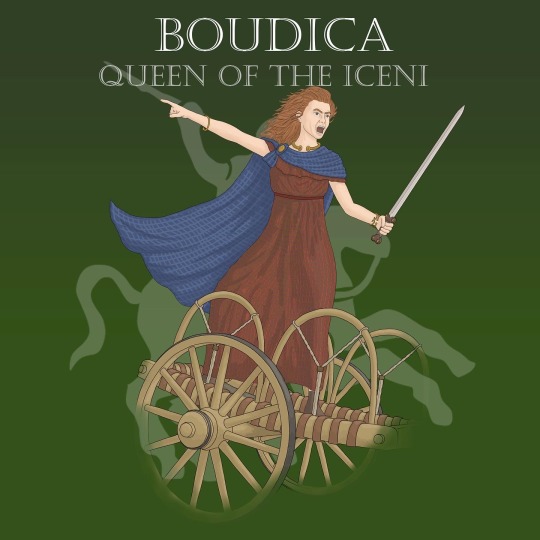
Boudica was a leader of the ancient British tribe the Iceni and is one of the most famous, or infamous, figures in ancient British history.
Though she is often referred to as ‘Queen of the Iceni’, Boudica was actually merely the wife of the king, Prasutagus, though in the end she would come to earn her regnal title in spirit if not in practice.
Occupying territory in what is now Norfolk, Suffolk and Cambridgeshire, the Iceni were one of the very few tribes in southern Britain that were not outright conquered by the Romans after their invasion in 49 CE. Instead, Prasutagus became a client king, loyal to the emperor but not directly governed by the Roman state.
Boudica and Prasutagus had only two daughters. Aware of how vulnerable his children would be after he was gone, Prasutagus drew up a will namig both Emperor Nero and his daughters as his heirs. This, he hoped, would allow his family to continue enjoying their client status.
But it was not to be. Almost as soon as Prasutagus died in either 60 or 61 CE, his will was disregarded by the Romans. The Iceni were to be formally absorbed into the empire. Catus Decianus, the procurator of Britannia, called in all the loans that had been given to the Iceni and Roman troops were sent to pillage the countryside. Eventually they made their way to the royal residence, where Boudica herself, no doubt still in mourning, was acosted and then flogged.
But the worse was yet to come. Boudica’s daughters, aged 10 and 12 respectively, were raped by the Roman soldiers.
This outrage was merely the icing on the cake and the Iceni almost immediately rose in revolt, with a wrathful Boudica at the helm.
It was fortuitous timing, because the bulk of the Roman forces in Britannia were busying invading the island of Mona (modern Angelsey, Northwest Wales) under the command of governor Suetonius Paulinus.
The first target of the rebels was the provincial capital at Camulodunum. The town had once been the seat of the Trinovantes, but had since been rebuilt as a Roman settlement populated by retired veterans and their families.
As virtually their entire tribe marched south, the Iceni were joined by the Trinovantes, who were just as eager to throw off the Roman yoke.
Cassius Dio reports that by the time the rebel army arrived in the vicinity of Camulodunun, it numbered 120,000. This almost certainly includes the women and children.
By contrast, Camulodunum had no defenses to speak of and no defenders to man them anyway. The city was immediately overwhelmed. What followed was an orgy of violence.
Some of the townspeople took refuge in the newly built Temple of Claudius, but many others were not so lucky. Thousands were massacred and many had their bodies mutilated as the Britons took vengeance for their mistreatment at the hands of the Romans.
For two days, the survivors held out in the temple. Eventually, Boudica ordered it to be burned, with everyone still inside. The destruction at Camulodunum was so thorough that, to this day, there remains a black destruction layer in the soil beneath the old city, filled with ash and shards of pottery and roof tiles.
While the Temple of Claudius was under siege, the Britons also destroyed a large detachment of the Legio IX Hispana sent to relieve the city.
With Camulodunum practically levelled, Boudica now turned her attention to the other major Roman settlement in the south: the trading centre at Londonium.
By this point word had reached Paulinus on Mona and he reacted decisively. He marched his army down the major thoroughfare that later came to be known as Watling Street, which terminated in Londinium itself.
With no troops to defend itself, Londinium was destined to suffer the same fate as Camulodunum. Once again, a major Roman city was subjected to a bloody sack. Once again, thousands were butchered and mutilated as the Britons vented their fury.
After Londinium, so went Verulamium (modern St Albans). By this point, Boudica’s army had slaughtered around 80,000 people, almost all of them civilians.
The Britons seemed unstoppable. Thousands flocked to Boudica’s banner, swelling her numbers to truly massive proportions.
Paulinus and Boudica met somewhere along Watling Street, though the precise location has been lost to history. Possessing perhaps 10,000 men, Paulinus faced off against a horde Cassius Dio records as numbering 230,000 men. Again, this likely refers to entire group, including the women and children. In any case, Boudica’s fighting men still outnumbered the Romans at least 5 to 1.
For the Britons, it seemed victory was at hand. All they had to do was destroy this small army.
But Paulinus had chosen his battlefield carefully, arraying his forces across a small defile that meant the Britons could only approach from the front.
As for the Britons, they occupied the plain below. The women and children arranged the hundreds of wagons in a great arc across the plain so that they could watch the coming spectacle.
When Boudica finally gave the order, her warriors surged forward in a direct assault, intending to overwhelm the Romans by numbers alone. Unfortunately, Boudica, formidable though she may be, was not an experienced military commander and the situation that her army now found itself in was exactly the kind of situation in which the Roman army was nigh on unstoppable.
The battle was a slaughter. Once the initial momentum of the Briton charge was spent, the Romans went to work and ground their enemies into the dirt. And the British numbers now worked against them. The sheer mass of warriors meant that those at the front were unable to retreat and they were cut down.
Paulinus delivered the coup de grace when his cavalry swept in from the flanks and a full on rout ensued.
But the disaster was about to get worse. The wall of wagons made it much harder for the Britons to withdraw and tens of thousands were killed as they attempted to squeeze through the narrow gaps en masse.
Tacitus reports that between 70,000 and 80,000 Britons died on that day, a truly staggering number. Paulinus’ victory could not have been more complete. Rome continued to rule Britannia for 350 years.
As for Boudica, her fate is not known for certain, but it has long been tradition that she, comprehending the scale of the catastrophe unfolding before her and unwilling to be captured, poisoned herself in the British camp. The fate of her daughters is unknown.
#history#real history#military history#ancient history#ancient rome#roman empire#rome#roman history#powerful women#historical women#ancient#roma series#roman emperor
15 notes
·
View notes
Photo

Today we celebrate the Protomartyr of Britain, Alban. Saint Alban was a Roman citizen who lived at Verulamium, a few miles northwest of London, during a time of persecution. Nothing is known about his family or his occupation. The chief magistrate of the city had orders to arrest all Christian clergy. One of them, a priest named Amphibalus, fled to Alban’s home in order to hide from the soldiers who wished to kill him. Alban was impressed by the priest’s constant prayer and vigil, and so he questioned Amphibalus about his beliefs. As a result, Alban came to believe in Christ and asked to be baptized. Eventually, Amphibalus was forced to move on, and Alban changed clothes with him so that he could get away. The soldiers heard there was a priest hiding in Alban’s house, so they came to search it. Seeing Alban dressed in the priest’s clothes, they arrested him and brought him before the judge. The magistrate was offering sacrifice to idols when Saint Alban appeared before him. After questioning him, he discovered how Alban and the priest had switched clothes. Furious because Alban had allowed a fugitive to escape, the magistrate threatened him with death unless he returned to paganism and revealed where Amphibalus had gone. Saint Alban replied, “I am also a Christian, and I worship the true God.” After having the saint beaten and tortured, the magistrate threatened him with execution. Saint Alban rejoiced and glorified God. The magistrate ordered the soldiers to take Saint Alban to the Holmhurst Hill to be beheaded. When they came to the river Ver, they saw that the bridge was crowded with people who had come to witness Alban’s martyrdom. Since they could not proceed because of the multitude of people, Saint Alban prayed and made the Sign of the Cross over the river. At once, the waters parted so that they were able to cross over to the other side. The executioner was so astonished by the miracle that he threw down his sword and refused to behead the saint. He was arrested, and another man was found to behead them both. May he intercede for us always + Source: https://www.oca.org/saints/lives/2008/06/22/101785-saint-alban-protomartyr-of-britain (at St. Albans City. UK) https://www.instagram.com/p/CfFMJlLv_0g/?igshid=NGJjMDIxMWI=
12 notes
·
View notes
Text
Luton Airport Taxi: Unlocking the top 10 things to do near London Luton airport
London Luton Airport is located in the middle of Bedfordshire, which is a busy county and acts as a gateway to London and the areas surrounding it. Upon arrival or departure from this busy aviation hub, tourists have many attractions to visit around.
In this blog post, we are going to take you through the top 10 things to do near London Luton Airport that will give you an idea about how versatile the place can be when it comes to adventurous souls.
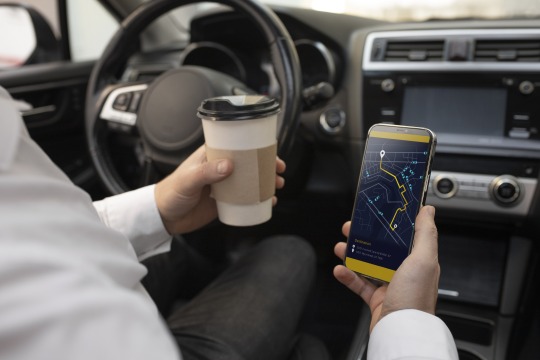
Top 10 Things to Do Near London Luton Airport
Sited in Bedfordshire’s vibrant district, London Luton Airport serves as a busy gateway into the vibrant city of London plus its environs. This airport hub has been attracting numerous travelers who pass through it when going or returning from different places hence being provided with several attractive destinations close by. The area around London Luton Airport offers various experiences ranging from fascinating museums and preserved historic sites to beautiful parks and country estates that appeal to all sorts of individuals.
Come along with us as we unmask for you the top 10 things to do around Luton Airport promising everlasting memories.
1. Whipsnade Zoo:
Experience animal encounters and help save animals at one of Europe’s largest wildlife conservation parks. Whipsnade Zoo is really preferred by those nature lovers who are looking for an adventure holiday.
2. B. Wardown Park Museum:
Get engrossed in local history and culture at this captivating museum situated in a stunning Victorian mansion.
3. C. Stockwood Discovery Centre:
For horticulture enthusiasts, there are gardens with interactive exhibits at this family-friendly attraction that deals with heritage of locality.
4. D. ZSL London Zoo:
As one of the oldest zoos globally, visit world of wildlife wonders right in the heart of our capital city today!
5. E. St Albans Cathedral:
Admire medieval architecture and rich historical pasts found at St Albans Cathedral which is only a short driving distance away from this airport
6. F. Ashridge Estate:
In Chiltern Hills Area of Outstanding Natural Beauty, take a trip through scenic walks or cycle trails in this picturesque estate.
7. G. Woburn Abbey:
Time travel to the past and explore an art collection, old furniture and beautiful gardens at Woburn Abbey.
8. H. Verulamium Park:
Take leisurely strolls or have picnics along this vast park which has got Roman ruins, calm lakes and lush greenery.
9. I. Dunstable Downs:
With its broad spread of countryside viewings, it is an ideal hilltop for all outdoor enthusiasts who enjoy hiking and kite flying.
10. J. Hitchin Lavender:
This farm serves as the most peaceful site for anyone wanting to wander through aromatic lavender fields and relish the beauty of nature there.
How to Book a Luton Airport Taxi Online?
A. Selecting a Reputable Taxi Booking Platform:
• Research different online airport taxi booking platforms
• Find companies that have positive testimonials, good customer service, reliable payment options
• Check if they cater specifically for Luton Airport transfers
B. Choosing Pickup and Drop-off Locations:
• Key in exact addresses of both pickup location and drop off location
• Specify any terminal or place within the airport where you want to be picked from
• Consider nearby landmarks or key places that will facilitate your movement around easily
C. Indicating Date and Time of Travel:
• State the date when you will arrive or leave Luton Airport.
• Take into account flight duration as well as congestion on roads at that time of day.
• If possible choose flexible arrangements so that you can change plans in case of anything.
D. Personalizing Preferences & Additional Services:
• Such as car type, number of travellers or any other things such as baby seats or wheelchair accessible.
• Explore more services offered by the booking platform like meet and greet services or extra luggage assistance.
• Book the ride as per your specific requirements and preferences.
E. Making Payment and Confirming Booking:
• Check the booking details to see if everything is accurate.
• Go to the payment section and select how you want to pay for it.
• Check whether there are additional fees or taxes you have to pay before confirming what needs to be paid
• Confirm payment for my booking with all relevant information and receive a confirmation of my payment.
Benefits of Booking a Luton Airport Taxi Transfers with Kabbi Compare
When traveling from London Luton Airport, a taxi is one of the ways that can be used so that movement can be made easier. The only thing we think about when travelling is how do we get around most efficiently. There is no other better way than using Kabbi Compare, which offers incredible Luton airport taxi transfers. From fixed prices to amazing customer service, when reaching your destination without hassles, choose Kabbi Compare taxis online thus having stress-free journey.
While highlighting some of these amazing places near Luton Airport waiting for our discovery, let’s also go into detail on why Kabbi Compare should be your choice Luton Airport transfer provider.
Expert Drivers:
In the course of driving passengers safely through their journey, polite and experienced drivers are put first by Kabbi Compare team.
Fixed Fares:
You will enjoy an honest pricing policy with Kabbi compare’s flat rate system; this saves customers from being hit by astonish costs or greedy price surges in peak hours.
Service Available 24/7:
Regardless if there are late night flights or early morning ones, Kabbi Compare still operates all day long every day making it possible to cope with them.
Track your Flight:
Kabbi Compare will always keep you informed of any changes in flight schedule and help you to be on time for departure or arrival.
Secureness:
A regulated taxi service that takes into account the wellbeing of the customers is what Kabbi Compare has to offer.
Easy Reservation:
Book a taxi through the website, or get a Kabbi Compare app and forget about irritating moments when booking a cab.
Different Vehicles Availability:
Standard cabs, minivans, luxurious cars – make your choice depending on your needs at Kabbiecompare.com
Free Cancelation Policy:
It is absolutely free in case you need to change your travel plans and cancel your booking with Kabbi compare.
Free Waiting Period:
To let people, have enough time to find the driver after landing, there is a free waiting time at Kabbi Compare.
Large Network Coverage:
Benefit from a wide range of reliable taxi providers using this convenient tool designed by Kabbi compare for different areas within its network to avoid making wrong choices.
Conclusion
Discovering attractions near Luton airport opens up an exciting world where one can dive into the rich tapestry of history, culture and natural beauty found in the region. There are many conveyance options available when visiting various places near Luton airport but only few are as convenient as hiring a reliable cab with Kabbi Compare, which paves way for comfortable transfers throughout the trip. Henceforth take advantage of booking Luton Airport taxi service if you are off for some adventurous sightseeing or going on a simple day out.
FAQs
How do I arrange a transfer from Luton Airport?
• You can book online for services provided by Kabbi compare that offer pre-booking facilities across multiple platforms. Just a quick and simple search, that’s it.
2. What are the available transportation options for pickups at Luton Airport?
• These include taxis, private hire cars, shuttle services and public transport such as buses and trains.
3. Can I pre-book a taxi transfer service at Luton Airport?
• Yes, you may book a taxi or transfer service for your arrival at Luton Airport. Booking in advance lets you reserve your transportation beforehand so that there are no hitches from the airport to wherever you’re going.
4. Are there any extra costs for airport pick-ups at Luton Airport?
• Luton Airport charges may differ depending on the mode of transport chosen by the customer and if they have special requests such as meet-and-greet services or additional stops along the way.
5. How long does it take to get from Luton Airport to central London by taxi or transfer service?
• The journey time between Luton Airport and central London using a taxi or transfer service depends on traffic congestion, the time of day and where exactly in London you are heading. On average it takes approximately 1 to 1.5 hours.
#luton airport taxi#luton airport transfer#luton airport taxi transfers#luton airport transfer service#taxi from luton airport#taxi service to luton airport
0 notes
Text
0 notes
Text
Verulamium Museum AR project
User Interface
The idea is to align with the museums theme and keep it simple. Also, avoid being too colorful and stick with the historical vibe.
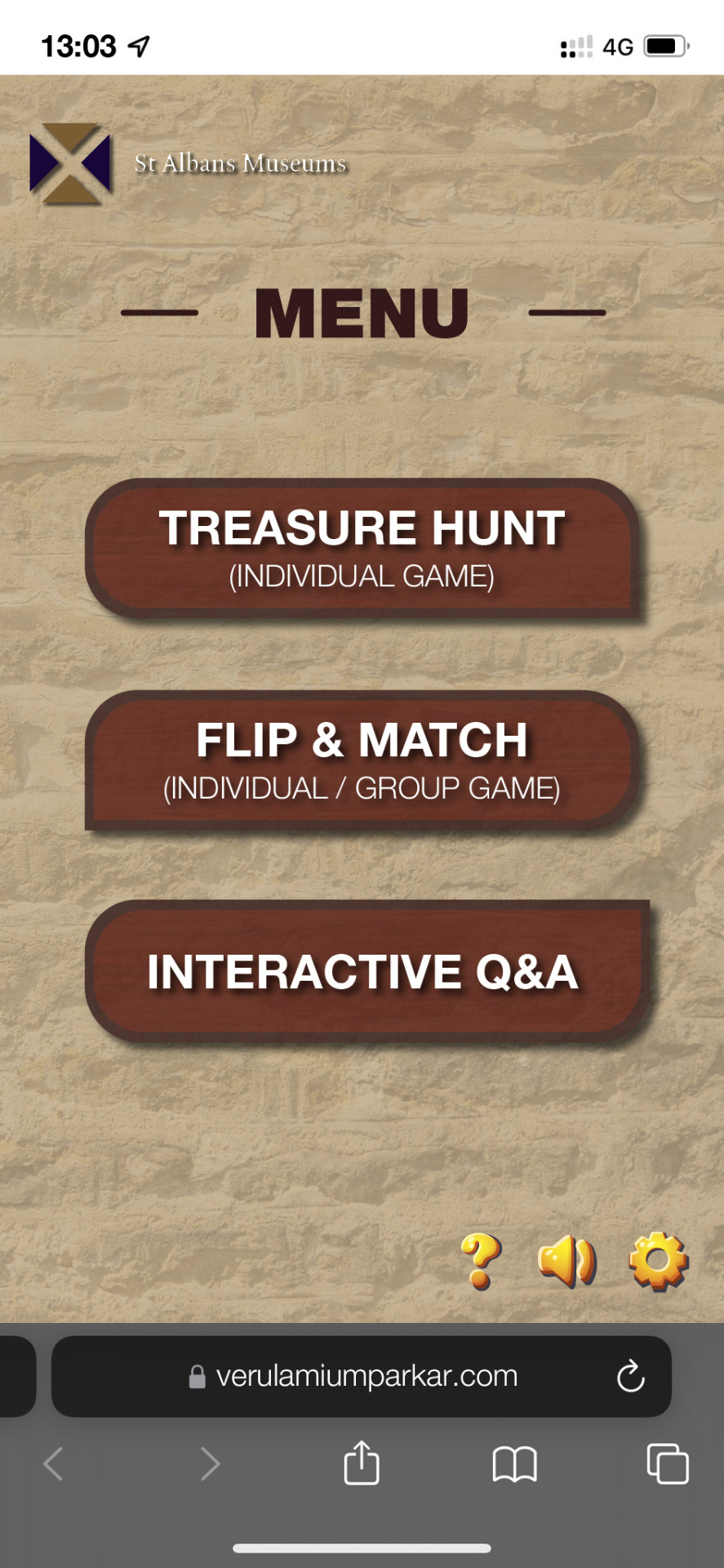
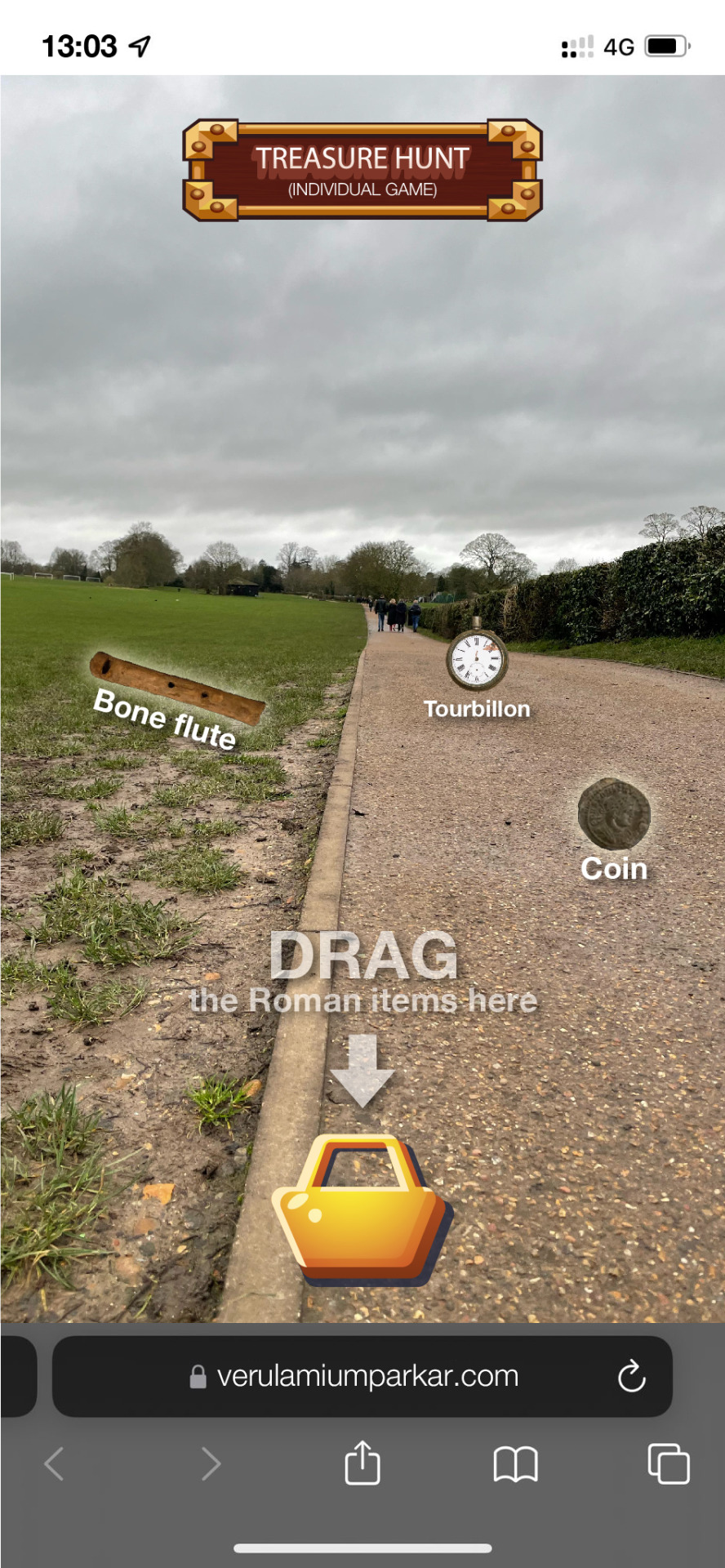
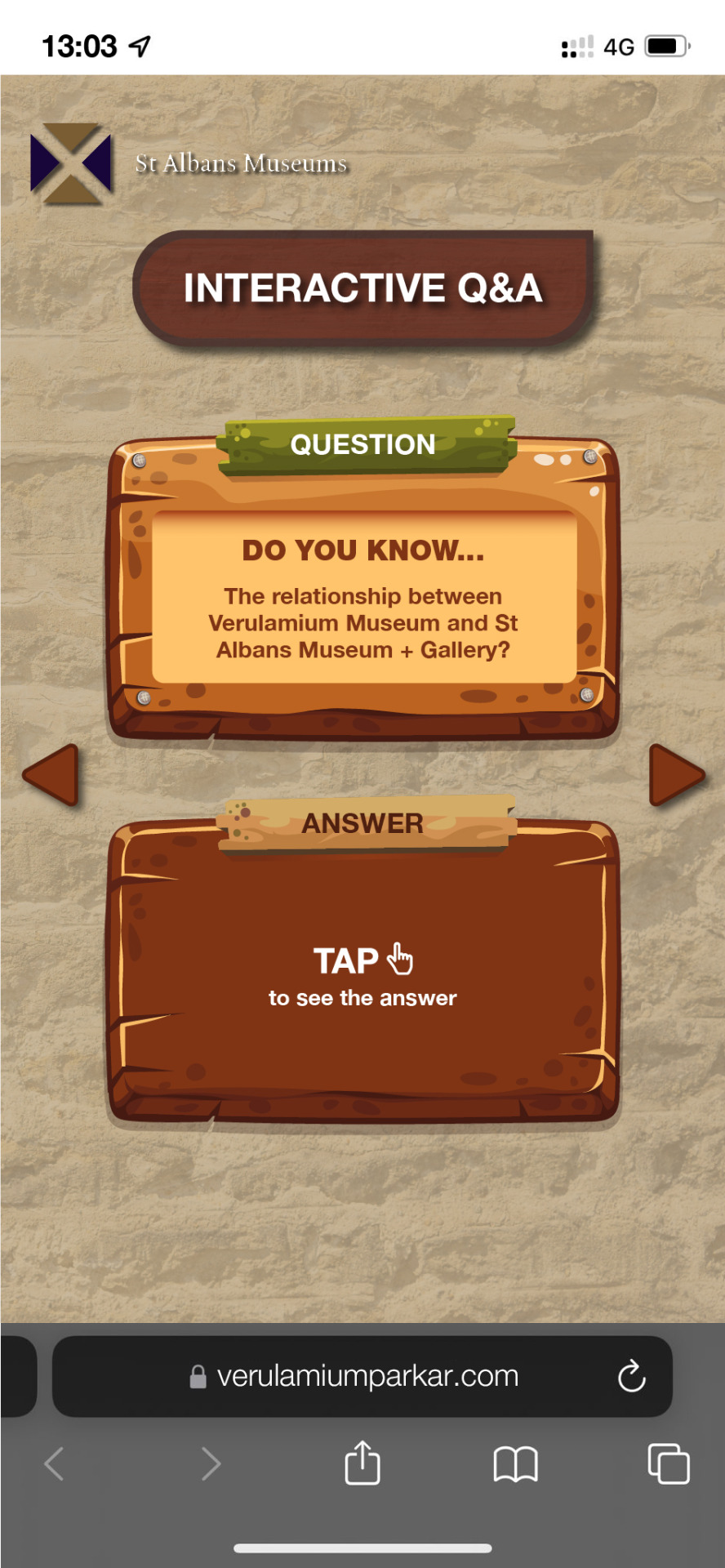

0 notes
Text
Audience Analyzing
In this project I need to analyze the type of visitor who using this website. Client is expecting that normally the people who visit the park are, parents coming with their children to the park, people come with their dogs to enjoy their leisure time, people come for evening walk etc.
In a session Xinge gave some idea about how to do the audience analyzation. The different methods are:
Demographics
Segmentation
Personas
Simulations
Here I used the 'Persona' method to analyze the personalities of people who will use this website. I used AI website for that which Xinge mentioned in the ppt.
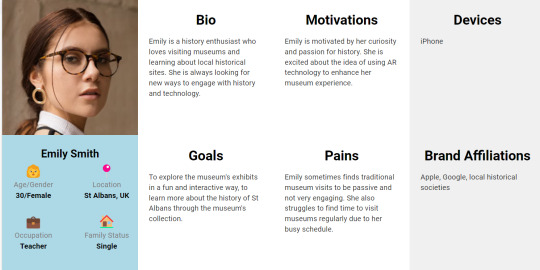
Emily seems like a perfect fit for the Verulamium website-based augmented reality experience based on her profile. Emily is a creative person who loves art and history. She looks for engaging and instructive activities that provide fresh perspectives and learning opportunities. Her interests would be satisfied by the augmented reality experience, which would give her an interesting way to explore Verulamium's historical sites and points of interest and interact with digital content superimposed on the real world. Furthermore, by providing a more engaging and dynamic substitute for conventional museum environments, the augmented reality encounter can
alleviate Emily's discomforts and improve her whole museum visitation experience.
Reference
1.https://userpersona.dev/
“A museum in St Albans, UK. AR treasure hunt for the museum to engage more people and explore the knowledge about the museum”.
0 notes
Text
Live Brief Project
Idea Generation and Developement
Goals and challenges
One of the less explored areas in the park is the Hypocaust and the Roman Mosaic building, mainly because of its relatively difficult-to-get location. When talking with the client, she told us that many times, groups of students go to the park as part of their 'My Local Area' study but that even if they are exploring the park in almost its totality they usually tend to avoid going to the Hypocaust because of this factor.
This building/location is actually one of the most interesting places in the park and it is full of history and fun facts; like the mistake in the mosaic; so when I started to think about ideas for the project this area caught my attention right away and I could see a lot of potential for it to attract people, especially kids/young people.
In the client's brief, they specified some of the project's goals and success criteria; my idea will approach these two specific points from the client's brief:
Increase by 30% hypocaust visits (1000 visits a month)
Improve the offer for local schools 'My Local Area Study'
One of the primary aims that the client has for this digital project is to engage audiences who already explore the park but are perhaps unaware or disengaged with its historical significance, so I'm focusing my idea on achieving that. At the same time, this idea will create a link between the St. Albans Museum, the Hypocaust-Mosaic building, and the Verulamium Museum.
The idea
MOS-AR: Explore the Hypocaust
My idea is to do a Web-AR Experience for the Hypocaust-Roman Mosaic Building.
The experience will be called 'MOS-AR' (Mosaic + AR) and it's a series of puzzle games and interactive information ('fun facts', 'did you know...') triggered by the actual mosaic inside the Hypocaust building.
The experience will be guided by a virtual character named Mos, a character inspired by the Roman Sea God from one of the other mosaics found in St. Albans, and will have 3 different levels depending on the age of the user:
Game 1 (Easiest Level): For kids between the ages of 3 and 9 years.
Game 2 (Mid Complexity Level): For teens between the ages of 10 to 15 years.
Game 3 (Complex Level): For audiences from 16 years onward; adults in general
With this experience, the user gets the chance to win a variety of prizes if they can successfully complete the game under the time limit; these prizes will renew each month and will have some constraints so that they are not overused by the public.
At the end of each game, Mos will invite the users to visit his mosaic 'portrait' at the Verulamium, where his soul is trapped. This will serve as a link between the Hypocaust and the Verulamium Museum, and can potentially become another similar WebAR experience where the users scan the Roman God Mosaic and 'free' his soul after completing a quiz or a puzzle. This will eventually attract more people to these locations and get them to engage with the Hypocaust-Mosaic Building and its history, and at the same time create a link between the Hypocaust and the Verulamium Museum.


Rules and Prizes
The prizes will be the same for all the games. The dynamic will work this way: each time the user wins they will unlock two things, a filter for them to take pictures/selfies and a ‘Spin the Wheel’ where the user gets the chance to win different prizes from the St. Albans Museum Café or Gift Shop, such as coffee discounts, specific merch discount (like extra discounts on clearance stuff, a free pastry when you buy a large coffee, a set of stickers from the gift shop, etc.) This will be completely random and the prizes will change each month.

Promotion of the Experience
The experience will be 'promoted' with several posters located in key areas of both St. Albans town (inside the Museum, walls, poles, etc.) and the actual park (the entrance, benches, boards), inviting the visitors to go visit the Hypocaust.
Developement of the AR Experience
One of the client's requirements for the project is using an App-free methodology to prevent users from dropping out of the experience and effectively engaging with them. Because of this, the perfect approach is to create the experience using Web AR Technologies.
What are WebAR Technologies?
Web-based Augmented Reality (WebAR) is the technology that allows augmented reality experiences to run in a web browser. It is a very useful technology as it doesn't require the user to download or buy any apps or special equipment to access the experiences.
Why Web AR?
Several studies have shown that adding interactivity to advertisement content can make its message stick to the audience's mind up to 80% more than static content does.
What makes this technology so attractive and user-friendly is that you can achieve that extra level of interaction without the need for a third-party app or website, users just have to enter a link or scan a QR code that immediately directs them to the browser to 'live' the experience.
'Offering the opportunity to ‘live the experience’ and ‘touch and feel a product’ is a powerful way of encouraging user engagement and purchase intent.' (Blippar, 2018)
There are many Web AR tools/software out there and they each have their pros and cons. However, after extensive research on these tools and what they offer, I concluded that the best option to develop this AR experience further would be 'Blippar'.
Blippar offers 3 main types of AR experiences that you can create with their Studio:
Marker-based AR: A specific picture (marker) is used as a target for the experience: the user points to their live mobile camera and the device must recognize the target to trigger the AR content.
Markerless AR: The user is the one who moves the virtual content through the space and decides where they want to place it. There's no need for a specific marker or a real-world anchor to trigger the AR content.
Location-based AR: The AR content is tied to a specific location in the real world. For this type of AR experience to work correctly, the device must be able to accurately figure out the location of the user.
The type that will be used for the creation of this experience is Marker-based AR: the experience will be triggered by the real-time 'image' of the mosaic.
Alongside the many functionalities that Blippar offers, they offer real-time feedback on your experience to monitor how many people interact with it and how your audience grows; this is ideal for the client as they want to know and monitor if and how the visits to the park improve.
References
What Is WebAR? How Web-based AR Works | Built In
Reinventing digital ads: AR increases engagement by 30% (blippar.com)
3 different types of AR explained: marker-based, markerless & location - News - Blippar
0 notes